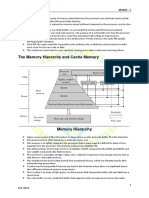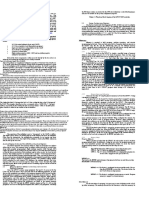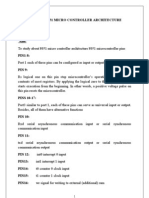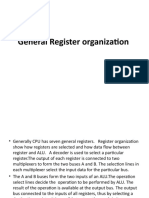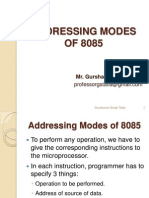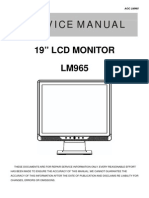0%(1)0% found this document useful (1 vote)
14K viewsBit Pair Recoding
Bit-pair recoding halves the number of summands needed for multiplication by recoding the multiplier bits. It works by recoding pairs of bits in the multiplier and selecting the appropriate version of the multiplicand based on the bit pair values. This allows the multiplication to be performed with only n/2 summands, rather than n summands as in standard multiplication methods.
Uploaded by
Connor HolmesCopyright
© Attribution Non-Commercial (BY-NC)
Available Formats
Download as PDF, TXT or read online on Scribd
0%(1)0% found this document useful (1 vote)
14K viewsBit Pair Recoding
Bit-pair recoding halves the number of summands needed for multiplication by recoding the multiplier bits. It works by recoding pairs of bits in the multiplier and selecting the appropriate version of the multiplicand based on the bit pair values. This allows the multiplication to be performed with only n/2 summands, rather than n summands as in standard multiplication methods.
Uploaded by
Connor HolmesCopyright
© Attribution Non-Commercial (BY-NC)
Available Formats
Download as PDF, TXT or read online on Scribd
You are on page 1/ 4
Fast Multiplication
Bit-Pair Recoding of Multipliers
Bit-Pair Recoding of Multipliers
Bit-pair recoding halves the maximum number of summands (versions of the multiplicand).
Sign extension 1 1 1 0 1 0 0 Implied 0 to right of LSB
1 +1 1
(a) Example of bit-pair recoding derived from Booth recoding
Bit-Pair Recoding of Multipliers
Multiplier bit-pair i +1 0 0 0 0 1 1 1 1 i 0 0 1 1 0 0 1 1 Multiplier bit on the right i 1 0 1 0 1 0 1 0 1 Multiplicand selected at position i 0 +1 +1 +2 2 1 1 0 M M M M M M M M
(b) Table of multiplicand selection decisions
Bit-Pair Recoding of Multipliers
0 1 1 0 1 0 - 1 +1 - 1 0 0 1 0 1 0 0 1 0 1 0 0 1 0 1 0 0 1 0 0 0 0 1 1 0 0 0 0 1 1 0 0 0 0 0 0 1 1 0 1 1
0 1 1 0 1 ( + 13) 1 1 0 1 0 (- 6 )
1 1 1 0 1 1 0 0 1 0 ( - 78)
0 1 1 0 1 -1 -2 0 1 1 1 1 1 0 0 1 1 0 1 1 1 1 0 0 1 1 0 0 0 0 0 0 1 1 1 0 1 1 0 0 1 0
4
Multiplication requiring only n/2 summands.
You might also like
- Essays Explaining What Has Happened To This WorldNo ratings yetEssays Explaining What Has Happened To This World6 pages
- 23-01-23 - Charter Buque Con JM SHIP SERVICE PANAMANo ratings yet23-01-23 - Charter Buque Con JM SHIP SERVICE PANAMA11 pages
- Chapter 2 - Parallel Interfacing With Microprocessor Based SystemNo ratings yetChapter 2 - Parallel Interfacing With Microprocessor Based System32 pages
- 7-Modified Booth Algorithm - Bit Pair Recoding-22-12-2022No ratings yet7-Modified Booth Algorithm - Bit Pair Recoding-22-12-202218 pages
- Features of Intel 8279 Programmable Keyboard Display InterfaceNo ratings yetFeatures of Intel 8279 Programmable Keyboard Display Interface26 pages
- Basic Concepts of Memory Interfacing - ComputerSCNo ratings yetBasic Concepts of Memory Interfacing - ComputerSC7 pages
- Half Subtractor and Full Subtractor VHDL Simulation CodeNo ratings yetHalf Subtractor and Full Subtractor VHDL Simulation Code7 pages
- UNIT-3 I/O and Memory Interfacing With 8051100% (1)UNIT-3 I/O and Memory Interfacing With 805142 pages
- Arithmetic Processor: 10-2 Addition and SubtractionNo ratings yetArithmetic Processor: 10-2 Addition and Subtraction9 pages
- Error Detection / Correction: Computer Organization & ArchitectureNo ratings yetError Detection / Correction: Computer Organization & Architecture18 pages
- Morris Mano - Computer Architecture PPT Chapter 7100% (2)Morris Mano - Computer Architecture PPT Chapter 726 pages
- Chapter 2introduction To The C2xx DSP Core and Code GenerationNo ratings yetChapter 2introduction To The C2xx DSP Core and Code Generation4 pages
- Question Bank: UNIT I - 8086 Microprocessor Part - A (2 Marks)100% (1)Question Bank: UNIT I - 8086 Microprocessor Part - A (2 Marks)10 pages
- Serial Communication Bus-Interface (Unit3)100% (2)Serial Communication Bus-Interface (Unit3)44 pages
- 28-5-I O Fundamentals Handshaking, Buffering-20!10!2021 (20-Oct-2021) Material I 20-10-2021 Unit-5-Lecture1100% (1)28-5-I O Fundamentals Handshaking, Buffering-20!10!2021 (20-Oct-2021) Material I 20-10-2021 Unit-5-Lecture115 pages
- Addition and Subtraction With Signed 2s ComplementNo ratings yetAddition and Subtraction With Signed 2s Complement3 pages
- Lecture 13 State Minimization of Sequential MachinesNo ratings yetLecture 13 State Minimization of Sequential Machines42 pages
- Cellular and Mobile Communication: Handoff Strategies Prioritizing Handoff Practical Handoff ConsiderationsNo ratings yetCellular and Mobile Communication: Handoff Strategies Prioritizing Handoff Practical Handoff Considerations20 pages
- 1 Interfacing Stepper Motor To 8086 Using 825582% (11)1 Interfacing Stepper Motor To 8086 Using 825540 pages
- MOSFET High Frequency Model and Amplifier Frequency ResponseNo ratings yetMOSFET High Frequency Model and Amplifier Frequency Response17 pages
- Module 5: Basic Processing Unit: I) Fundamental Concepts of ProcessorNo ratings yetModule 5: Basic Processing Unit: I) Fundamental Concepts of Processor16 pages
- booth algorithm and fast multiplicationNo ratings yetbooth algorithm and fast multiplication21 pages
- Chapter 8 Accounts Receivable ConfigurationNo ratings yetChapter 8 Accounts Receivable Configuration12 pages
- Upright Blood Bank Refrigerator Brochure PDFNo ratings yetUpright Blood Bank Refrigerator Brochure PDF8 pages
- Jigsaw Puzzle Competition Social NarrativeNo ratings yetJigsaw Puzzle Competition Social Narrative15 pages
- Https LMC - Up.nic - in Internet AuthenticatedUser TaxSubmit - AspxNo ratings yetHttps LMC - Up.nic - in Internet AuthenticatedUser TaxSubmit - Aspx2 pages
- Government of India Directorate General of Civil Aviation Form CA-80B Application For Design Organisation Approval (DOA) Under CAR 21, Subpart JBNo ratings yetGovernment of India Directorate General of Civil Aviation Form CA-80B Application For Design Organisation Approval (DOA) Under CAR 21, Subpart JB2 pages
- The Impact of Technological Advancements On Philippine SocietyNo ratings yetThe Impact of Technological Advancements On Philippine Society2 pages
- Request Tracker For Incident Response (RTIR) : Kevin Falcone Best Practical SolutionsNo ratings yetRequest Tracker For Incident Response (RTIR) : Kevin Falcone Best Practical Solutions50 pages
- 1.1 Presentation - Class - Visual Perception and Preattentive AttributesNo ratings yet1.1 Presentation - Class - Visual Perception and Preattentive Attributes118 pages
- 23-01-23 - Charter Buque Con JM SHIP SERVICE PANAMA23-01-23 - Charter Buque Con JM SHIP SERVICE PANAMA
- Chapter 2 - Parallel Interfacing With Microprocessor Based SystemChapter 2 - Parallel Interfacing With Microprocessor Based System
- 7-Modified Booth Algorithm - Bit Pair Recoding-22-12-20227-Modified Booth Algorithm - Bit Pair Recoding-22-12-2022
- Features of Intel 8279 Programmable Keyboard Display InterfaceFeatures of Intel 8279 Programmable Keyboard Display Interface
- Half Subtractor and Full Subtractor VHDL Simulation CodeHalf Subtractor and Full Subtractor VHDL Simulation Code
- Arithmetic Processor: 10-2 Addition and SubtractionArithmetic Processor: 10-2 Addition and Subtraction
- Error Detection / Correction: Computer Organization & ArchitectureError Detection / Correction: Computer Organization & Architecture
- Chapter 2introduction To The C2xx DSP Core and Code GenerationChapter 2introduction To The C2xx DSP Core and Code Generation
- Question Bank: UNIT I - 8086 Microprocessor Part - A (2 Marks)Question Bank: UNIT I - 8086 Microprocessor Part - A (2 Marks)
- 28-5-I O Fundamentals Handshaking, Buffering-20!10!2021 (20-Oct-2021) Material I 20-10-2021 Unit-5-Lecture128-5-I O Fundamentals Handshaking, Buffering-20!10!2021 (20-Oct-2021) Material I 20-10-2021 Unit-5-Lecture1
- Addition and Subtraction With Signed 2s ComplementAddition and Subtraction With Signed 2s Complement
- Lecture 13 State Minimization of Sequential MachinesLecture 13 State Minimization of Sequential Machines
- Cellular and Mobile Communication: Handoff Strategies Prioritizing Handoff Practical Handoff ConsiderationsCellular and Mobile Communication: Handoff Strategies Prioritizing Handoff Practical Handoff Considerations
- MOSFET High Frequency Model and Amplifier Frequency ResponseMOSFET High Frequency Model and Amplifier Frequency Response
- Module 5: Basic Processing Unit: I) Fundamental Concepts of ProcessorModule 5: Basic Processing Unit: I) Fundamental Concepts of Processor
- Https LMC - Up.nic - in Internet AuthenticatedUser TaxSubmit - AspxHttps LMC - Up.nic - in Internet AuthenticatedUser TaxSubmit - Aspx
- Government of India Directorate General of Civil Aviation Form CA-80B Application For Design Organisation Approval (DOA) Under CAR 21, Subpart JBGovernment of India Directorate General of Civil Aviation Form CA-80B Application For Design Organisation Approval (DOA) Under CAR 21, Subpart JB
- The Impact of Technological Advancements On Philippine SocietyThe Impact of Technological Advancements On Philippine Society
- Request Tracker For Incident Response (RTIR) : Kevin Falcone Best Practical SolutionsRequest Tracker For Incident Response (RTIR) : Kevin Falcone Best Practical Solutions
- 1.1 Presentation - Class - Visual Perception and Preattentive Attributes1.1 Presentation - Class - Visual Perception and Preattentive Attributes





